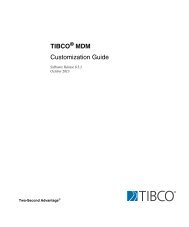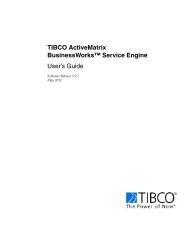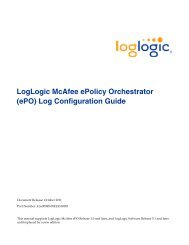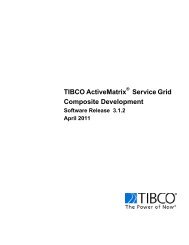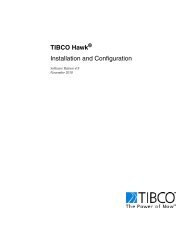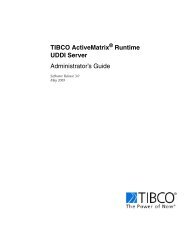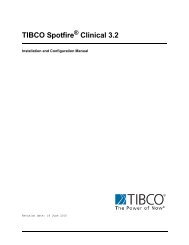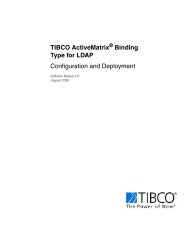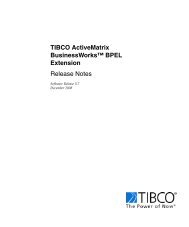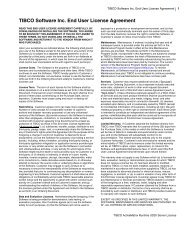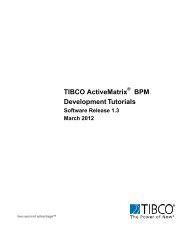TIBCO Spotfire Server 3.2.2 - TIBCO Product Documentation
TIBCO Spotfire Server 3.2.2 - TIBCO Product Documentation
TIBCO Spotfire Server 3.2.2 - TIBCO Product Documentation
Create successful ePaper yourself
Turn your PDF publications into a flip-book with our unique Google optimized e-Paper software.
Installing <strong>Spotfire</strong> <strong>Server</strong> 3.2<br />
If you plan to run only a single <strong>Spotfire</strong> <strong>Server</strong>, you will most likely install both the<br />
<strong>Spotfire</strong> <strong>Server</strong> and the <strong>Spotfire</strong> Configuration Console on the same machine. In a<br />
clustered environment with several <strong>Spotfire</strong> <strong>Server</strong>s, it is often preferable to install the<br />
configuration console on a separate machine. This way, you can avoid having the<br />
configuration console going down if you for instance need to bring down a <strong>Spotfire</strong><br />
<strong>Server</strong> machine for maintenance.<br />
For more information on the configuration console and what it does, see “Install the<br />
Configuration Console” on page 26.<br />
2.3.3 Run Installer<br />
MIGRATING OR UPGRADING?<br />
Running 10.1, 3.0, or 3.1 and 3.2 on the Same Machine<br />
It is possible to run two versions of the server on the same machine as<br />
long as they communicate on different ports.<br />
The <strong>Spotfire</strong> <strong>Server</strong> installer will ask for three ports: <strong>Spotfire</strong> <strong>Server</strong><br />
port, Configuration Console port, and <strong>Spotfire</strong> Controller port. Each of<br />
these applications is described in the section “Architectural Overview”<br />
on page 6. Ensure that you do not select any port that is already in use<br />
by 10.1 or 3.0. Before starting the <strong>Spotfire</strong> <strong>Server</strong>, you must also make<br />
sure that none of the other ports used by the servers collide. All port<br />
numbers are specified in the file server.xml, located in the directory<br />
/server/conf/ on the 10.1 server, and<br />
/tomcat/conf/ on the 3.0, 3.1, and 3.2<br />
server. For a full specification of this file, see the section “<strong>Server</strong>.xml”<br />
on page 135.<br />
Microsoft SQL <strong>Server</strong> Windows Integrated Login<br />
If the 3.0 or 3.1 installation authenticates with a Microsoft SQL <strong>Server</strong><br />
using Windows Integrated Login, it is important to install and run the<br />
3.2 server using the same Windows Domain user.<br />
Alternatively, you can re-configure your Microsoft SQL <strong>Server</strong> to<br />
accept another Windows Domain user to access the <strong>Spotfire</strong> database.<br />
See also the section “Run the Upgrade Tool” on page 38 for<br />
information about the upgrade tool and Windows Integrated Login.<br />
In the installation kit, you will find the installer (install.exe or install.bin). Copy this<br />
file to the machine on which you want to install the <strong>Spotfire</strong> <strong>Server</strong>.<br />
It is possible to run the <strong>Spotfire</strong> <strong>Server</strong> installer silently using predefined parameters.<br />
This is useful when you wish to install several servers with the same setup. See<br />
“Installing <strong>Spotfire</strong> <strong>Server</strong> Silently Using Pre-defined Parameters” on page 84 for<br />
more information.<br />
<strong>TIBCO</strong> <strong>Spotfire</strong>® <strong>Server</strong> <strong>3.2.2</strong> 23 (144)



